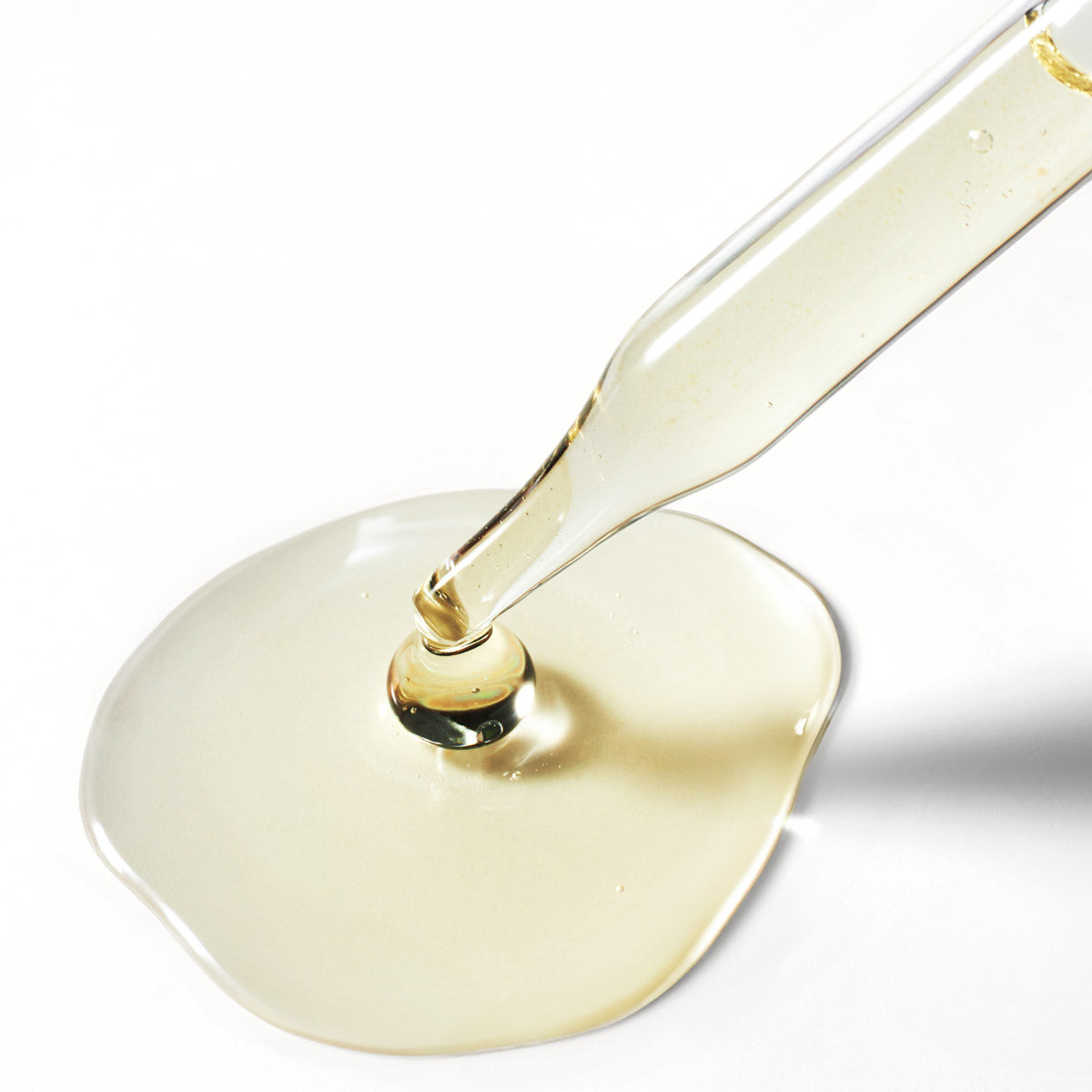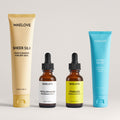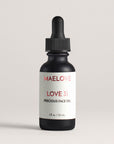
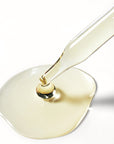
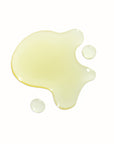
LOVE 31 Botanical Facial Oil
Most orders are processed and shipped within two business days (Mon - Fri). You’ll receive an email with tracking details as soon as yours is on its way.
For US-based shoppers, shipping is on us for orders $50 and over. Anything less is a flat $6.95 charge.
100-Day Peace of Mind: Skincare is a journey, and we're with you. You have a full 100 days to try your products. If you aren't satisfied, returns are free and easy through our self-serve portal or a quick note to team@maelove.com
Immediately:
- Your skin feels instantly supple. This dry oil sinks in fast to lock in hydration, giving you a dewy, spa-like glow and a smooth base for makeup.
Weeks 2 to 3:
- Your skin feels deeply hydrated and soft, and that tight, dry feeling starts to disappear.
Weeks 4 and beyond:
- Redness starts calming noticeably. Makeup glides on more smoothly. Your skin stops overreacting to triggers, and the glow becomes your new normal.
Immediate suppleness is just the start, and the best results come from playing the long game. Because the benefits are cumulative, your skin looks its best when you’re consistent.


We went through over 90 iterations calibrating this 31-ingredient "cocktail" to ensure every drop delivers a nutrient-dense oil that actually sinks in.
BARRIER REPAIR (Evening Primrose, Argan, Hemp)
- High-potency omega fatty acids mimic your skin’s natural lipids to "patch" your moisture barrier.
- This restores resilience so your skin feels calm and protected, not raw or reactive.
HEALING & RADIANCE (Tamanu, Pomegranate, Rosehip)
- Antioxidant-rich oils speed up recovery and balance oil production.
- They work together to fade the look of redness and smooth your texture for that signature "juicy" glow.
THE "DRY OIL" BASE (Grapeseed, Squalane, Jojoba)
- Selected for their small molecular size, these ensure the luxury actives absorb fast.
- You get deep nourishment and a velvety finish that wears beautifully under your makeup.
Apply AM and/or PM, after serums.
Dispense 2-3 drops into your palm, rub hands together, then press gently onto your face, neck, and chest. The oil absorbs in 1-2 minutes
The scent is natural and floral (jasmine, rose, lavender) with no added fragrance. Most customers love it ("spa-like"), while some find it strong at first. It fades within 3-5 minutes and doesn't linger on your skin.
Product Reviews


For the Curious
Love 31 is a luxurious facial oil that uses a decadent blend of nature's most effective oils. With anti-inflammatory, antioxidant, antimicrobial, and healing properties, this nourishing formula is the ultimate skin indulgence.
Vitis Vinifera (Grape) Seed Oil, Simmondsia Chinensis (Jojoba) Seed Oil, Aqua (Water), Leuconostoc/Radish Root Ferment Filtrate, Cannabis Sativa (Hemp) Seed Oil, Punica Granatum (Pomegranate) Seed Oil, Argania Spinosa (Argan) Kernel Oil, Adansonia Digitata (Baobab) Seed Oil, Squalane, Oxycoccus Palustris (Arctic Cranberry) Seed Oil, Rosa Canina (Rosehip) Fruit Oil, Helianthus Annuus (Sunflower) Seed Oil, Persea Gratissima (Avocado) Oil, Prunus Amygdalus Dulcis (Sweet Almond) Oil, Corylus Avellana (Hazelnut) Seed Oil, Olea Europaea (Olive) Fruit Oil, Linum Usitatissimum (Linseed) Seed Oil, Prunus Armeniaca (Apricot) Kernel Oil, Rosa Damascena (Rose) Flower Oil, Limnanthes Alba (Meadowfoam) Seed Oil, Salix Alba (Willow) Bark Extract, Jasminum Officinale (Jasmine) Oil, Lavandula Angustifolia (Lavender) Oil, Oenothera Biennis (Evening Primrose) Oil, Caprylyl Glycol, Calophyllum Inophyllum (Tamanu) Seed Oil, Cucurbita Pepo (Pumpkin) Seed Oil, Citrus Limon Peel Oil, Tocopherol (D-alpha), Tocotrienols, Citrus Aurantium Dulcis Peel Oil, Elaeis Guineensis Oil
Facial oils can provide many benefits and is particularly beneficial for those with dry and mature skin. First, facial oils will lock in moisture and prevent water evaporation. Second, oils can fill in gaps in the skin barrier to smooth the skin surface. By layering a facial oil over other treatments, you can also create a protective barrier that helps your skin absorb and retain the active ingredients. In addition, they can contain healing and protective properties and have been used in traditional medicine for wound healing and treatment of skin conditions for centuries.
Love 31 contains several plant oils that are particularly effective at treating dry, damaged skin. Oils from sweet almond and sunflower seed are used to treat dryness in infant skin and to treat eczema (Aksucu et al. 2022, Poljsak and Glavac 2022). Jojoba oil is more accurately described as a liquid wax and has a structure similar to sperm whale oil. It is the only liquid wax readily extractible in large quantities from plant sources and is particularly effective at treating dry skin as well as softening skin without being greasy (Gad et al. 2021). Avocado and argan oils also treat dryness in skin and can also condition hair (Lin et al. 2017, Vaughn et al 2018).
Botanical oils contain omega fatty acids that heal the skin barrier. In particular omega-6 fatty acids linoleic acid and gamma linolenic acid and omega-3 fatty acid linolenic acid have been shown to heal the skin barrier. Sunflower seed, hemp seed, grape seed and pumpkin seed oils are high in linoleic acid, rose hip oils are high in both linoleic and linolenic acid, and evening primrose oil consists almost entirely of linoleic and gamma linoleic acid (Lin et al. 2017, Moore et al. 2020). Evening primrose oil is particularly effective in treating eczema (Poljsak and Glavac 2022). Pomegranate seed and linseed oils have wound healing properties and can stimulate the regeneration of epidermal skin cells (Aslam et al 2006, Beroual et al. 2017).
Botanical oils also contain anti-inflammatory and antioxidant compounds. Oils that have shown to contain these protective compounds include baobab seed, rose hip, argan, tamanu and sunflower oils (Lin et al. 2017). Grape seed oil is the star when it comes to antioxidants. It is high in natural levels of antioxidant vitamin E (tocopherol and tocotrienol) and contains a synergistic combination of polyphenols resulting in high antioxidant activity that can protect against UV damage. These include potent antioxidants called procyanidin B1, B2 and C1 and proanthocyanidins which are both antioxidants and antimicrobials (Garavaglia et al. 2016, Gupta et al). Meadowfoam seed oil also contains phyto-compounds that can help reduce UV photoaging (Carpenter et al. 2018).
Botanical oils also contain antimicrobial phyto-compounds. Tamanu oil in particular has long been used in traditional medicine in treating ulcers and wounds with natural antiseptic properties (Cassien et al. 2021). Apricot kernel oil has also been used in traditional medicine to treat skin diseases and has antimicobrial activity against bacteria and yeasts (Lee et al. 2014). Jojoba oil as well has a wide history of use as a medicinal plant to treat skin and scalp disorders and wounds. It has anti-fungal and antimicrobial properties and has been used to treat acne, psoriasis and wounds (Vaughn et al. 2018).
Facial oils can be used in the place of a moisturizer to hydrate the skin and lock in other actives. Facial oils can also be mixed with moisturizers to make the moisturizer more hydrating such as during winter when cold, dry air causes skin to become dry and flaky. Facial oils may also be used as a primer under makeup and will leave a smooth surface atop which makeup can glide on. Facial oils can also be applied as spot treatment on dry areas.
When choosing a facial oil, it's important to consider your skin type and any specific concerns you have, as oils offer different benefits. Always patch test a new facial oil to ensure it suits your skin and doesn't cause any adverse reactions.
Overall, Love 31 Botanical Facial Oil is designed to benefit a wide range of skin types by providing hydration, nourishment, anti-aging and skin soothing plant oils. Its lightweight, fast-absorbing formula ensures it won't leave your skin feeling greasy, making it a great addition to any skincare routine.
In particular, those with normal to very dry skin or damaged skin may find this oil can offer deep moisturization that is hard to achieve with other products. Jojoba oil is a liquid wax with a structure similar to sperm whale oil and is high in monounsaturated omega-9 fatty acid gondoic acid (Gad et al. 2021, Lin et al. 2017, Moore et al. 2020). Sweet almond and sunflower seed oils are used to treat dryness in neonatal skin and to treat eczema (Aksucu et al. 2022, Poljsak and Glavac 2022). Argan oil can help repair the skin barrier (Lin et al. 2017) and has been traditionally used in the treatment of skin infections (Monfalouti et al. 2010). Evening Primrose oil is another oil that is particularly effective in treating eczema and consists of linoleic and gamma linoleic acid (Poljsak and Glavac 2022). Other oils high in skin barrier healing omega fatty acids linoleic and linolenic acid include hemp seed, pumpkin seed, grapeseed, and rose hip oils (Lin et al. 2017, Moore et al. 2020).
For those with mature skin, oils will not only help deal with the dryness and weakened skin barrier accompanying aging with the oils listed above, some oils have special properties that can additionally aid aging skin. Pomegranate seed and linseed oils have wound healing properties and can stimulate the regeneration of epidermal skin cells (Aslam et al 2006, Beroual et al. 2017). Oils can also provide vitamins, antioxidants and phytocompounds that help protect the skin from photo-aging from UV damage. Grapeseed oil is particular has high natural levels of vitamin E and a synergistic combination of polyphenols with high antioxidant activity ((Garavaglia et al. 2016, Gupta et al. 2020). Meadowfoam seed oil has also been shown to contain phyto-compounds that can help reduce UV photoaging (Carpenter et al. 2018).
Those with inflamed skin and redness, and problem skin can also benefit from botanical oils that have been traditionally used for wound healing with anti-inflammatory and antimicrobial function. Tamanu oil has long been used in traditional medicine in treating ulcers and wounds, and has natural antiseptic and anti-inflammatory properties (Cassien et al. 2021). Jojoba oil also has a wide history of use as a medicinal plant to treat skin and scalp disorders and wounds (Vaughn et al. 2018). Argan oil as been traditionally used in the treatment of skin infections (Monfalouti et al. 2010). Baobab seed oil has been used in traditional medicine as a skin conditioner and also has anti-inflammatory compounds (Msalilwa et al. 2020). Grapeseed oil has been found to effectively help in wound healing and contains natural antimicrobials (Nayak et al. 2011, Vaughn et al. 2018). Apricot kernel oil has been used in traditional medicine to treat skin diseases and has antimicobrial activity against bacteria and yeasts (Lee et al. 2014). Finally, omega-3 and omega-6 oils are powerful anti-inflammatories that can heal the skin barrier and are found in many of the plant oils found in Love 31.
Always patch test a new facial oil to ensure it suits your skin and doesn't cause any adverse reactions.
Plant oils can provide both short and long-term benefits to address skin dryness. Oils will lock in moisture by forming a waterproof seal. Oils can fill in gaps in the skin barrier that allow moisture to escape and can smooth the skin surface. They can also coat the skin with a thin layer of lipids that further help lock in moisture. By layering a facial oil over other treatments, you can also create a protective barrier that helps your skin absorb and retain the active ingredients.
The oils contained in Love 31 are particularly well suited to addressing skin dryness. For example, sweet almond and sunflower seed oils are used to treat dryness in neonatal skin and to treat eczema (Aksucu et al. 2022, Poljsak and Glavac 2022). Jojoba oil is actually composed mostly of wax (98%) and is more accurately described as a liquid wax. It reduces TEWL and softens skin without being greasy. (Gad et al. 2021). Love 31 also contains many botanical oils high in omega fatty acids that can help heal the skin barrier. These include sunflower seed, hemp seed, pumpkin Seed, grapeseed oils high in linoleic acid, rose hip oil high in linoleic and linolenic acid and evening primrose oil which is almost all linoleic and gamma linoleic acid and is also particular effective in treating eczema (Lin et al. 2017, Moore et al. 2020).
Love 31 is chock full of plant oils renowned for their antioxidant, anti-inflammatory and antimicrobial activity.
Grapeseed oil is the real star when it comes to antioxidants. It is high in natural levels of vitamin E (tocopherol and tocotrienol) and contains a synergistic combination of polyphenols resulting in high antioxidant activity (Garavaglia et al. 2016, Gupta et al.) These include potent antioxidants called procyanidin B1, B2 and C1 and proanthocyanidins are antioxidants and antimicrobials (Vaughn et al. 2018). These antioxidants can help protect against UV damage. Additionally, Meadowfoam seed oil contains phyto-compounds that can help reduce UV induced photoaging (Carpenter et al. 2018).
Botanical oils are also high in omega fatty acids that can help heal the skin barrier and are powerful anti-inflammatories. Sunflower seed, hemp Seed, grape seed and pumpkin seed oils are high in linoleic acid, Rosehip oils are high in both linoleic and linolenic acid, and evening primrose oil is almost entirely linoleic and gamma linoleic acid (Lin et al. 2017, Moore et al. 2020). Evening primrose oil is particularly effective in treating eczema (Poljsak and Glavac 2022). Other botanical oils that also contain antioxidant and anti-inflammatory phyto-compounds including baobab seed, rose hip, argan, tamanu and sunflower oils (Msalilwa et al. 2020, Lin et al. 2017).
Botanical oils also contain antimicrobial phyto-compounds. Tamanu oil in particular has long been used in traditional medicine in treating ulcers and wounds with natural antiseptic properties. In has lipids and bioactive phytocompounds such as sterols, coumarins, triterpenoids and flavonoids (Cassien et al. 2021). Apricot Kernel Oil has also been used in traditional medicine to treat skin diseases and has antimicobrial activity against bacteria and yeasts (Lee et al. 2014). Jojoba oil as well has a wide history of use as a medicinal plant to treat skin and scalp disorders and wounds. It has anti-fungal and antimicrobial properties and has been used to treat acne, psoriasis and wounds (Vaughn et al. 2018). Argan oil has also been traditionally used in the treatment of skin infections (Monfalouti et al. 2010). Other oils that help in wound healing include pomegranate seed and grapeseed oils (Aslam et al 2006, Nayak et al. 2011).
The deeply hydrating, skin barrier healing properties of oils and especially those rich in omega fatty acids such as linoleic, linolenic, and gamma linolenic acid will help reduce the appearance of fine lines and wrinkles. Sunflower seed, hemp seed, grape seed and pumpkin seed oils are high in linoleic acid, rose hip oils are high in both linoleic and linolenic acid, and evening primrose oil consists almost entirely of linoleic and gamma linoleic acid (Lin et al. 2017, Moore et al. 2020).
Further, both pomegranate seed and linseed oils have been shown to stimulate the regeneration of epidermal skin cells, a process which slows with aging (Aslam et al 2006, Beroual et al. 2017). Grapeseed oil rich in UV protective vitamins and antioxidant polyphenols including procyanidin B1, B2 and C1 and proanthocyanidins (Vaughn et al. 2018) and Meadowfoam seed oil contains phyto-compounds that can help reduce UV induced photoaging (Carpenter et al. 2018) can help protect the skin against photo-aging.
Love 31 is also chock full of plant oils renowned for their antioxidant, anti-inflammatory and antimicrobial activity as well as oils that are particularly well suited to locking in moisture and smoothing the skin surface as described above. These properties are also going to help soothe, smooth and hydrated the inflamed, red, rough and dry skin that often accompanies aging.
We do not use any perfumes or artificial fragrance in this formula or any other Maelove product. Thanks to the blend of natural botanical oils, many customers report that Love 31 has a pleasant floral scent.
To achieve the light and quick absorbing feel and texture, each production run entails 17 precisely executed steps. Over 90 versions were required to perfect this product due to the immense complexity in calibrating the multitude of ingredients for superior skin feel while maintaining formula stability. Each production batch undergoes a stringent quality control to confirm the correct balance of ingredients.
Love 31 is made in USA and is also European Union compliant, cruelty-free, gluten-free and vegan.
Aksucu G, Azak M, Caglar S (2022). “Effects of Topical Oils on Neonatal Skin: A Systematic Review.” Adv Skin Wound Care 35: 1-9.
Aslam MN, Lansky EP, Varani J (2006). “Pomegranate as a cosmeceutical source: Pomegranate fractions promote proliferation and procollagen synthesis and inhibit matrix metalloproteinases-1 production in human skin cells.” J Ethnopharmacol 103: 311-318.
Beroual K, Agabou A, Abdeldjelil M, Boutaghane N, Haouam S, Hamdi-Pacha Y (2017). “Evaluation of crude flaxseed oil in burn wound healing in New Zealand rabbits ” Afr J Tradit Complement Altern Med. 14(3); 280-286.
Carpenter E, Le M, Miranda C, Reed R, Stevens J, Indra A, Ganguli-Indra G (2018). “Photoprotective Properties of Isothiocyanate and Nitrile Glucosinolate Derivatives from Meadowfoam (Limnanthes alba) Against UVB Irradiation in Human Skin Equivalent.” Front Pharmacol 9:477.
Cassien M, Mercier A, Thetiot-Laurent S, Culcasi M, Ricquebourg E, Asteian A, Herbette G, Bianchini J, Raharivaelomanana P, Pietri S (2021). “Improving the Antioxidant Properties of Calophyllum inophyllum Seed Oil from French Polynesia: Development and Biological Applications of Resinoud Ethanol-Soluble Extracts.” Antioxidants 10: 199. doi.org/10.3390/antiox10020199.
Gad HA, Roberts A, Hamzi SH, Gad HA, Touiss I, Altyar AE, Kensara OA, Ashour ML (2021). “Jojoba Oil: An Updated Comprehensive Review on Chemistry, Pharmaceutical Uses, and Toxicity.” Polymers 13: 1711. /doi.org/10.3390/polym13111711.
Garavaglia J, Markoski M, Oliveira A, Marcadenti A (2016). “Grape Seed Oil Compounds: Biological and Chemical Actions for Health. Nutrition Metabolic Insights 9:59-64.
Gupta M, Dey S, Marbaniang D, Pal P, Ray S, Masumder B (2020). “Grape seed extract: having a potential health benefit.” J Food Sci Technol 57(4): 1205-1215.
Lee H, Ahn H, Kwon A, Lee E, Kwak J, Min U (2014). “Chemical composition and Antimicrobial activity of the Essential Oil of Apricot Seed.” Phytotherapy Research 28(1): 1867-1872.
Lin T, Zhong L, Santiago JL (2017). “Anti-inflammatory and Skin Barrier Repair Effects of Topical Application of Some Plant Oils.” Int J Mol Sci 19: 70. doi.10.3390/ijms19010070.
Moore EM, Wagner C, Komarnytsky S (2020). “The Enigma of Bioactivity and Toxicity of Botanical Oils for Skin Care.” Front Pharmacol 11:785. doi:10.2289/fphar.2020.00785.
Poljsak N, Glavac N (2022). “Vegetable Butters and Oils as Therapeutically and Cosmetically Active Ingredients for Dermal Use: A Review of Clinical STudies.” Front Pharmacol. 13: 868461.
Vaughn AR, Clark AK, Sivamani RK, Shi VY (2018). “Natural Oils for Skin-Barrier RepairL Ancient Compounds Now Backed by Modern Science.” Am J Clin Dermatol 19: 103-117.
Aksucu G, Azak M, Caglar S (2022). “Effects of Topical Oils on Neonatal Skin: A Systematic Review.” Adv Skin Wound Care 35: 1-9.
Aslam MN, Lansky EP, Varani J (2006). “Pomegranate as a cosmeceutical source: Pomegranate fractions promote proliferation and procollagen synthesis and inhibit matrix metalloproteinases-1 production in human skin cells.” J Ethnopharmacol 103: 311-318.
Beroual K, Agabou A, Abdeldjelil M, Boutaghane N, Haouam S, Hamdi-Pacha Y (2017). “Evaluation of crude flaxseed oil in burn wound healing in New Zealand rabbits ” Afr J Tradit Complement Altern Med. 14(3); 280-286.
Carpenter E, Le M, Miranda C, Reed R, Stevens J, Indra A, Ganguli-Indra G (2018). “Photoprotective Properties of Isothiocyanate and Nitrile Glucosinolate Derivatives from Meadowfoam (Limnanthes alba) Against UVB Irradiation in Human Skin Equivalent.” Front Pharmacol 9:477.
Cassien M, Mercier A, Thetiot-Laurent S, Culcasi M, Ricquebourg E, Asteian A, Herbette G, Bianchini J, Raharivaelomanana P, Pietri S (2021). “Improving the Antioxidant Properties of Calophyllum inophyllum Seed Oil from French Polynesia: Development and Biological Applications of Resinoud Ethanol-Soluble Extracts.” Antioxidants 10: 199. doi.org/10.3390/antiox10020199.
Gad HA, Roberts A, Hamzi SH, Gad HA, Touiss I, Altyar AE, Kensara OA, Ashour ML (2021). “Jojoba Oil: An Updated Comprehensive Review on Chemistry, Pharmaceutical Uses, and Toxicity.” Polymers 13: 1711. /doi.org/10.3390/polym13111711.
Garavaglia J, Markoski M, Oliveira A, Marcadenti A (2016). “Grape Seed Oil Compounds: Biological and Chemical Actions for Health. Nutrition Metabolic Insights 9:59-64.
Gupta M, Dey S, Marbaniang D, Pal P, Ray S, Masumder B (2020). “Grape seed extract: having a potential health benefit.” J Food Sci Technol 57(4): 1205-1215.
Lee H, Ahn H, Kwon A, Lee E, Kwak J, Min U (2014). “Chemical composition and Antimicrobial activity of the Essential Oil of Apricot Seed.” Phytotherapy Research 28(1): 1867-1872.
Lin T, Zhong L, Santiago JL (2017). “Anti-inflammatory and Skin Barrier Repair Effects of Topical Application of Some Plant Oils.” Int J Mol Sci 19: 70. doi.10.3390/ijms19010070.
Monfalouti H, Guillaume D, Denhez C, Charrouf Z (2010). “Therapeutic potential of argan oil: a review.” JPP 62: 1669-1675.
Moore EM, Wagner C, Komarnytsky S (2020). “The Enigma of Bioactivity and Toxicity of Botanical Oils for Skin Care.” Front Pharmacol 11:785. doi:10.2289/fphar.2020.00785.
Msalilwa U, Makule E, Munishi L, Ndakidemi P. “Physiochemical Properties, Fatty Acid Composition and the Effect of Heating on the Reduction of Cyclopropenoid Fatty Acids on Baobab.” J Lipids doi.org/10.1155/2020/6691298.
Nayak B, Ramdath D, Marshall J, Isitor G, Xue S, Shi J. (2011). “Wound-healing properties of the oils of Vitis vinifera and Vaccinium macrocarpon.” Phytother Res 25(8): 1201-1208.
Poljsak N, Glavac N (2022). “Vegetable Butters and Oils as Therapeutically and Cosmetically Active Ingredients for Dermal Use: A Review of Clinical STudies.” Front Pharmacol. 13: 868461.
Vaughn AR, Clark AK, Sivamani RK, Shi VY (2018). “Natural Oils for Skin-Barrier RepairL Ancient Compounds Now Backed by Modern Science.” Am J Clin Dermatol 19: 103-11
Aksucu G, Azak M, Caglar S (2022). “Effects of Topical Oils on Neonatal Skin: A Systematic Review.” Adv Skin Wound Care 35: 1-9.
Gad HA, Roberts A, Hamzi SH, Gad HA, Touiss I, Altyar AE, Kensara OA, Ashour ML (2021). “Jojoba Oil: An Updated Comprehensive Review on Chemistry, Pharmaceutical Uses, and Toxicity.” Polymers 13: 1711. /doi.org/10.3390/polym13111711.
Lin T, Zhong L, Santiago JL (2017). “Anti-inflammatory and Skin Barrier Repair Effects of Topical Application of Some Plant Oils.” Int J Mol Sci 19: 70. doi.10.3390/ijms19010070.
Moore EM, Wagner C, Komarnytsky S (2020). “The Enigma of Bioactivity and Toxicity of Botanical Oils for Skin Care.” Front Pharmacol 11:785. doi:10.2289/fphar.2020.00785.
Poljsak N, Glavac N (2022). “Vegetable Butters and Oils as Therapeutically and Cosmetically Active Ingredients for Dermal Use: A Review of Clinical STudies.” Front Pharmacol. 13: 868461.
Aslam MN, Lansky EP, Varani J (2006). “Pomegranate as a cosmeceutical source: Pomegranate fractions promote proliferation and procollagen synthesis and inhibit matrix metalloproteinases-1 production in human skin cells.” J Ethnopharmacol 103: 311-318.
Carpenter E, Le M, Miranda C, Reed R, Stevens J, Indra A, Ganguli-Indra G (2018). “Photoprotective Properties of Isothiocyanate and Nitrile Glucosinolate Derivatives from Meadowfoam (Limnanthes alba) Against UVB Irradiation in Human Skin Equivalent.” Front Pharmacol 9:477.
Cassien M, Mercier A, Thetiot-Laurent S, Culcasi M, Ricquebourg E, Asteian A, Herbette G, Bianchini J, Raharivaelomanana P, Pietri S (2021). “Improving the Antioxidant Properties of Calophyllum inophyllum Seed Oil from French Polynesia: Development and Biological Applications of Resinoud Ethanol-Soluble Extracts.” Antioxidants 10: 199. doi.org/10.3390/antiox10020199.
Garavaglia J, Markoski M, Oliveira A, Marcadenti A (2016). “Grape Seed Oil Compounds: Biological and Chemical Actions for Health. Nutrition Metabolic Insights 9:59-64.
Gupta M, Dey S, Marbaniang D, Pal P, Ray S, Masumder B (2020). “Grape seed extract: having a potential health benefit.” J Food Sci Technol 57(4): 1205-1215.
Lee H, Ahn H, Kwon A, Lee E, Kwak J, Min U (2014). “Chemical composition and Antimicrobial activity of the Essential Oil of Apricot Seed.” Phytotherapy Research 28(1): 1867-1872.
Lin T, Zhong L, Santiago JL (2017). “Anti-inflammatory and Skin Barrier Repair Effects of Topical Application of Some Plant Oils.” Int J Mol Sci 19: 70. doi.10.3390/ijms19010070.
Monfalouti H, Guillaume D, Denhez C, Charrouf Z (2010). “Therapeutic potential of argan oil: a review.” JPP 62: 1669-1675.
Moore EM, Wagner C, Komarnytsky S (2020). “The Enigma of Bioactivity and Toxicity of Botanical Oils for Skin Care.” Front Pharmacol 11:785. doi:10.2289/fphar.2020.00785.
Msalilwa U, Makule E, Munishi L, Ndakidemi P. “Physiochemical Properties, Fatty Acid Composition and the Effect of Heating on the Reduction of Cyclopropenoid Fatty Acids on Baobab.” J Lipids doi.org/10.1155/2020/6691298.
Nayak B, Ramdath D, Marshall J, Isitor G, Xue S, Shi J. (2011). “Wound-healing properties of the oils of Vitis vinifera and Vaccinium macrocarpon.” Phytother Res 25(8): 1201-1208.
Poljsak N, Glavac N (2022). “Vegetable Butters and Oils as Therapeutically and Cosmetically Active Ingredients for Dermal Use: A Review of Clinical STudies.” Front Pharmacol. 13: 868461.
Vaughn AR, Clark AK, Sivamani RK, Shi VY (2018). “Natural Oils for Skin-Barrier RepairL Ancient Compounds Now Backed by Modern Science.” Am J Clin Dermatol 19: 103-117.
Aslam MN, Lansky EP, Varani J (2006). “Pomegranate as a cosmeceutical source: Pomegranate fractions promote proliferation and procollagen synthesis and inhibit matrix metalloproteinases-1 production in human skin cells.” J Ethnopharmacol 103: 311-318.
Beroual K, Agabou A, Abdeldjelil M, Boutaghane N, Baouam S, Hamdi-Pacha Y (2017). “Evaluation of crude flaxseed oil in burn wound healing in new zealand rabbits.” Afr J Tradit Complement Altern Med 14(3): 280-286.
Carpenter EL, Le MN, Miranda CL, Reed RL, Stevens JF, Indra AK, Ganguli-Indra G. “Photoprotective properties of Isothiocyanate and Nitrile Glucosinolate Derivatives From Meadowfoam (Limnanthes alba) Against UVB Irradiation in Human Skin Equivalent.” Front Pharmacol 9:477. doi: 10.3389/fphar.2018.00477.
Lin T, Zhong L, Santiago JL (2017). “Anti-inflammatory and Skin Barrier Repair Effects of Topical Application of Some Plant Oils.” Int J Mol Sci 19: 70. doi.10.3390/ijms19010070.
Moore EM, Wagner C, Komarnytsky S (2020). “The Enigma of Bioactivity and Toxicity of Botanical Oils for Skin Care.” Front Pharmacol 11:785. doi:10.2289/fphar.2020.00785.
Vaughn AR, Clark AK, Sivamani RK, Shi VY (2018). “Natural Oils for Skin-Barrier RepairL Ancient Compounds Now Backed by Modern Science.” Am J Clin Dermatol 19: 103-117.

